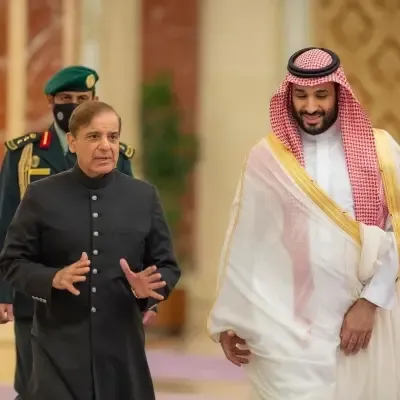Can Saudi MoU Challenge Pakistan’s Commitment?

Synopsis
Key Takeaways
- Saudi-funded industrial city in Punjab could boost Pakistan's economy.
- Investments will target special economic zones, logistics, and infrastructure.
- Past projects like CPEC highlight the need for accountability.
- Energy security and bureaucratic hurdles must be addressed.
- Focus on sectors aligned with Saudi Vision 2030.
New Delhi, Nov 9 (NationPress) The newly established Memorandum of Understanding (MoU) between the Punjab government and the Saudi-Pakistan Joint Business Council is being viewed as a potential turning point for the revival of Pakistan’s industry.
This agreement outlines plans for a Saudi-funded industrial city in Punjab, directing investments into special economic zones (SEZs), logistics, and infrastructure, along with incentives like tax holidays and customs exemptions.
Nevertheless, amidst the optimistic declarations lies a significant examination of Pakistan’s capacity to fulfill its own commitments, as highlighted in a report by Asian Lite.
Similar to previous initiatives like the China-Pakistan Economic Corridor (CPEC), the Saudi-Pakistan MoU is perceived more as a declaration of intent rather than a definitive obligation.
The report also points out that historical experiences do not inspire much hope.
Years after the CPEC was initiated, numerous projects are still unfinished, and Chinese investors have voiced concerns regarding issues like non-payments, security risks, and inconsistent policies, the report underscores.
For Saudi investment to thrive where others have stumbled, Pakistan must first tackle its enduring challenges — including unreliable energy supplies, bureaucratic obstacles, inadequate infrastructure, and a volatile foreign exchange system.
Investors need clear land titles, serviced industrial sites, and assured access to power and logistics before any tangible progress can occur.
Energy insecurity remains a significant hurdle. Frequent power outages have hampered industrial productivity, while policy instability and tax complexities continue to deter major global corporations like BP, Siemens, and Chevron.
Another critical challenge is Pakistan’s foreign exchange restrictions.
In recent years, various multinational companies and foreign airlines have faced difficulties in repatriating profits due to balance-of-payments crises. Without solid guarantees on currency convertibility and profit transfers, foreign investors remain hesitant.
Experts recommend that the proposed industrial city in Punjab should concentrate on specific sectors aligned with Saudi Arabia’s Vision 2030, such as construction materials, halal food processing, and medical devices, instead of attempting to accommodate every industry.
In the end, the MoU is not merely an achievement but a test of governance, policy consistency, and Pakistan’s ability to translate promises into actual results.
If lessons are not learned from the shortcomings of CPEC, this Saudi initiative may also become yet another unfulfilled aspiration.









